
How Long Should You Rest Between Sets to Build Muscle?
Recently, research has been coming out showing that long rest periods between sets are best for building muscle. When you rest for longer, your muscles recover more of their strength, allowing you to lift more weight in subsequent sets. Lifting more weight means more mechanical tension and, thus, better strength gains. Because of this, most powerlifters rest for 2–5 minutes between sets.
A decade ago, short rest times were thought to be better for building muscle. Bodybuilders would rest just 30–60 seconds between sets, keeping their workouts short, their heart rates high, and revelling in their muscle pumps. They built tremendous amounts of muscle.
Both approaches can be ideal for building muscle. The trick is to build your program in a way that takes advantage of both styles of training.
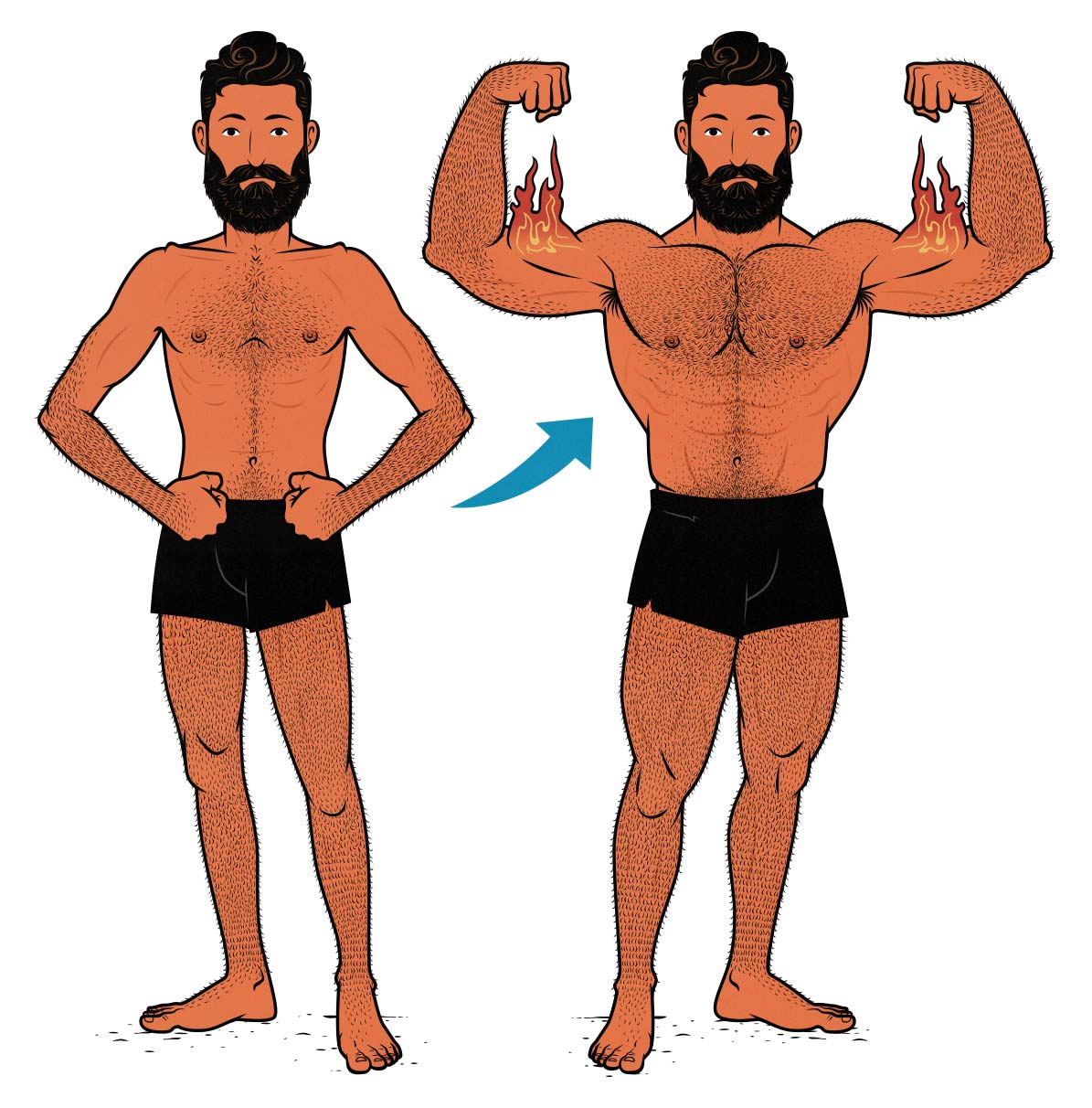
The Benefits of Long Rest Times
Better Recovery Between Sets
The reason long rest periods are good for building muscle is that they give us a chance to catch our breath and recover our strength between sets. If we don’t catch our breath between sets, we might be limited by our cardiovascular systems instead of by the strength of our muscles, and so we might cause the wrong type of adaptation—we’d grow fitter instead of stronger. And if we don’t recover our strength between sets, we won’t be able to lift as heavy for as many reps, putting less mechanical tension on our muscles. We’d still be stimulating muscle growth with every challenging set, but we’d need to do more sets to make up for the dwindling training volume.
However, fully recovering our strength between sets can require monstrously long rest periods. A 2020 study found that resting eight minutes between sets allowed people to maintain more reps from set to set than five-minute rests, and it’s unclear if that’s even the limit. Imagine how many sets you could do within that same timeframe. Even if you aren’t getting as many reps in later sets, the overall training volume would still be much higher, presumably leading to more muscle growth within the same timeframe.
Better Strength Gains
The next thing to consider is strength. Gaining strength isn’t just about gaining muscle, it’s also about training ourselves to contract our muscles as forcefully as possible. To practice that, we need to be starting each set feeling fairly fresh. This is why strength trainees often leave a couple of reps in reserve, rest for at least a few minutes between their sets, and stop doing sets before they get too fatigued. It’s conceivable that if we bring this mindset into our hypertrophy training, we’d learn to lift heavier weights, allowing us to stimulate more muscle growth with every set.
All three of these points make logical sense, and all three were subsequently backed up by well-conducted research, leaving us little doubt that longer rest times can certainly help us build more muscle:
- Dr Schoenfeld’s famous 2016 study found that 3-minute rest periods yielded more muscle growth than 1-minute rest periods when lifting in the 8–12 rep range.
- Another 2016 study found that 5-minute rest periods roughly doubled the amount of protein synthesis compared to 1-minute rest periods.
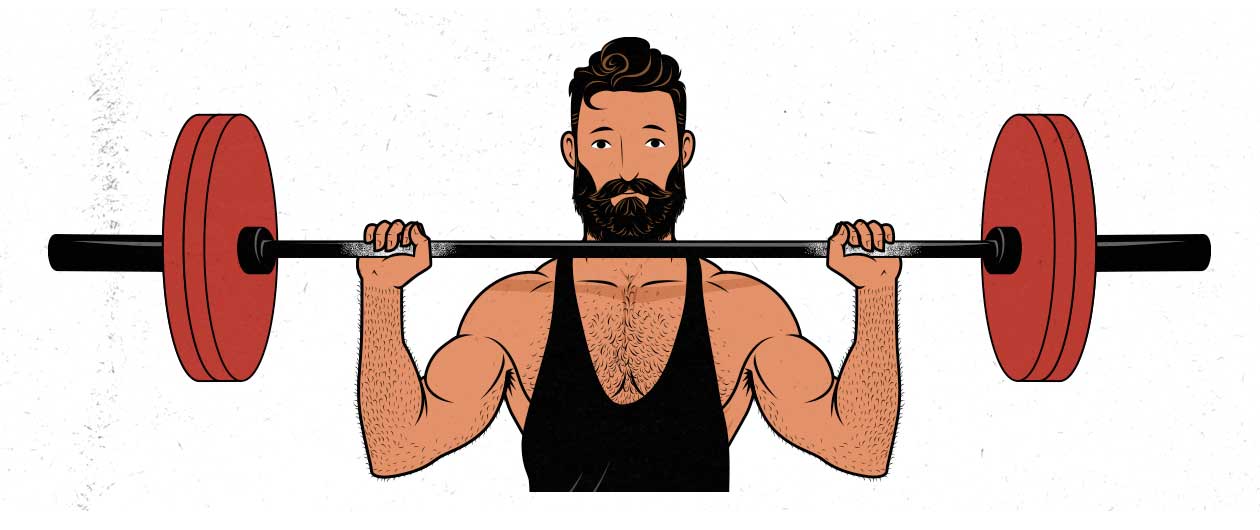
Now, we’re seeing that both 3-minute and 5-minute rest periods were tested. 2-minute rest periods are often tested as well. But there’s no magical number of minutes we need to wait. It all depends on how heavy the lift is, how big the range of motion is, how many reps we do, how fit we are, and how much time we’re willing to spend waiting between sets.
Recovery Times Vary Greatly
For example, the conventional deadlift uses a larger range of motion and engages more of our upper-back musculature than the sumo deadlift, causing it to use 25-40% more energy (study). As a result, we’re often able to eke out more reps and get away with shorter rest periods when using a sumo stance. Mind you, conventional deadlifts might be the better lift for building muscle and improving our fitness. And as we get stronger, deadlifts will only get harder on our cardiovascular systems, allowing us to get even more robust fitness improvements from lifting weights.
- Stronger lifters are able to lift heavier weights or do more reps, meaning they’re doing more work, and thus it takes them longer to recover between sets.
- Heavier compound lifts (such as squats and deadlifts) engage more muscle mass and burn through more resources, increasing the amount of time it takes to recover between sets.
- Lifting with a larger range of motion means doing more work, again increasing recovery times.
- Fitter lifters are able to recover more quickly between sets.
A thin lifter with a history of doing cardiovascular training will recover faster between sets, perhaps to the point where he can get away with doing supersets. On the other hand, a grizzled powerlifter might need a nap between sets. Hell, he may even get winded halfway through a set of ten.
Here’s a simple rule of thumb: rest until your breathing has returned almost to normal. That might be 5 minutes between heavy sets of squats, 2 minutes between sets of biceps curls, or 1 minute between sets of wrist curls.
The Benefits of Short Rest Times
More Growth Hormone From Shorter Rest Times?
So, first of all, there may be a myth to banish. One of the reasons that short rest times were thought to cause more muscle growth is that they were associated with elevations in growth hormones. This idea even had a name: the hormone hypothesis. Bodybuilders would design their entire workout routines to maximize anabolic hormone production. The thing is, despite its awesome name, recent research shows that growth hormone doesn’t cause extra muscle growth.
It seems like higher training volumes cause more muscle growth and more growth hormone production. The growth hormone isn’t causing the muscle growth, it’s merely being produced alongside the growth. The short rest times were allowing bodybuilders to fit more high-rep sets into their workouts, raising their training volume up way higher, and it was that extra training volume that was making their bodybuilding routines so effective. Now, that doesn’t mean that short rest times aren’t good for hypertrophy, it just means that the mechanism may have been misunderstood. In this case, it seems like the shorter rest times were merely a way to do more work in less time.
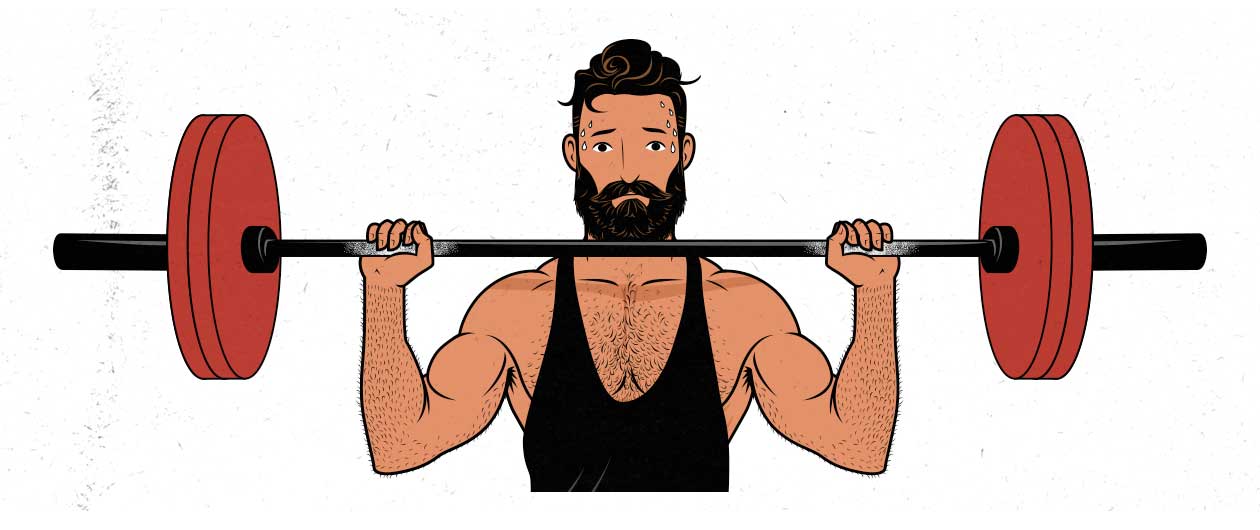
More Sarcoplasmic Hypertrophy?
What’s neat about workouts designed to pack a ton of work into a short timeframe, though, is that they cause us to adapt by storing more fuel in our muscles—sarcoplasmic hypertrophy. We aren’t just improving our maximal strength, we’re also improving our ability to do more work in less time. And both of those adaptations will make us bigger, more capable, and better looking.
Hypertrophy training is the combination of increased strength and muscular work capacity.
Eric Helms, PhD
Sarcoplasmic hypertrophy is sometimes thought of as being an inferior type of muscle growth. People assume it will lead to softer muscles or fewer performance benefits. That isn’t true.
First, since the growth is still taking place within our muscle fibres, there’s no reason to think that our muscles would look or feel any different. Second, developing a greater work capacity is an incredibly useful performance advantage. If you want to lift things more times, survive longer workouts, or carry things greater distances, having more sarcoplasm is a huge advantage.
Short Rest Times for Fitness
Plus, muscle growth aside, short rest times can also be incredibly healthy, especially if we don’t do very much dedicated cardiovascular training. Short rest times are great for improving our general fitness, work capacity, and oxygen delivery. That’s why a lot of general fitness lifting programs use circuit training with short rest times between each exercise. You also see this same idea being used with high-intensity interval training (HIIT), where cardiovascular fitness is improved by doing a series of short bursts of intense work with inadequate rest periods between them. That’s not so different from doing a few ten-rep sets of squats with 1–2 minutes of rest between them.
Short Rest Times for Muscle Growth
But we do care about muscle growth, and it would suck to stay weak and skinny just for the sake of living longer and healthier lives. Fortunately, by using higher-rep sets and shorter rest times, if we do it right, we can get more muscle growth than with longer rest periods. For example, this study found that using shorter rest times roughly doubled muscle growth:
- Long rest times, 8 reps per set: muscles grew 5% bigger.
- Short rest times, 20 reps per set: muscles grew 10% bigger.
If we use examples of extremely short rest periods, such as drop sets, where we lift to failure (or close to it), reduce the weight by 20–25%, and then immediately do another set, we see some nifty research findings:
- 3 Normal sets with 90-second rest periods: muscles grew 5% bigger.
- 1 Normal set with 3 drop sets: muscles grew 10% bigger.
In this case, what we’re seeing is that drop sets can allow us to build more muscle in less time, perhaps simply by increasing the number of challenging sets we’re doing in our workouts—by increasing our training volume.
With shorter rest times, we can do more sets in less time, improving the efficiency of our workouts (study). For example, we could do a single heavy set and then a few quick drop sets. We may need to do four sets instead of three, but we’d still finish all four sets inside two minutes, whereas it might take us a good ten minutes to get through three sets with longer rest periods.
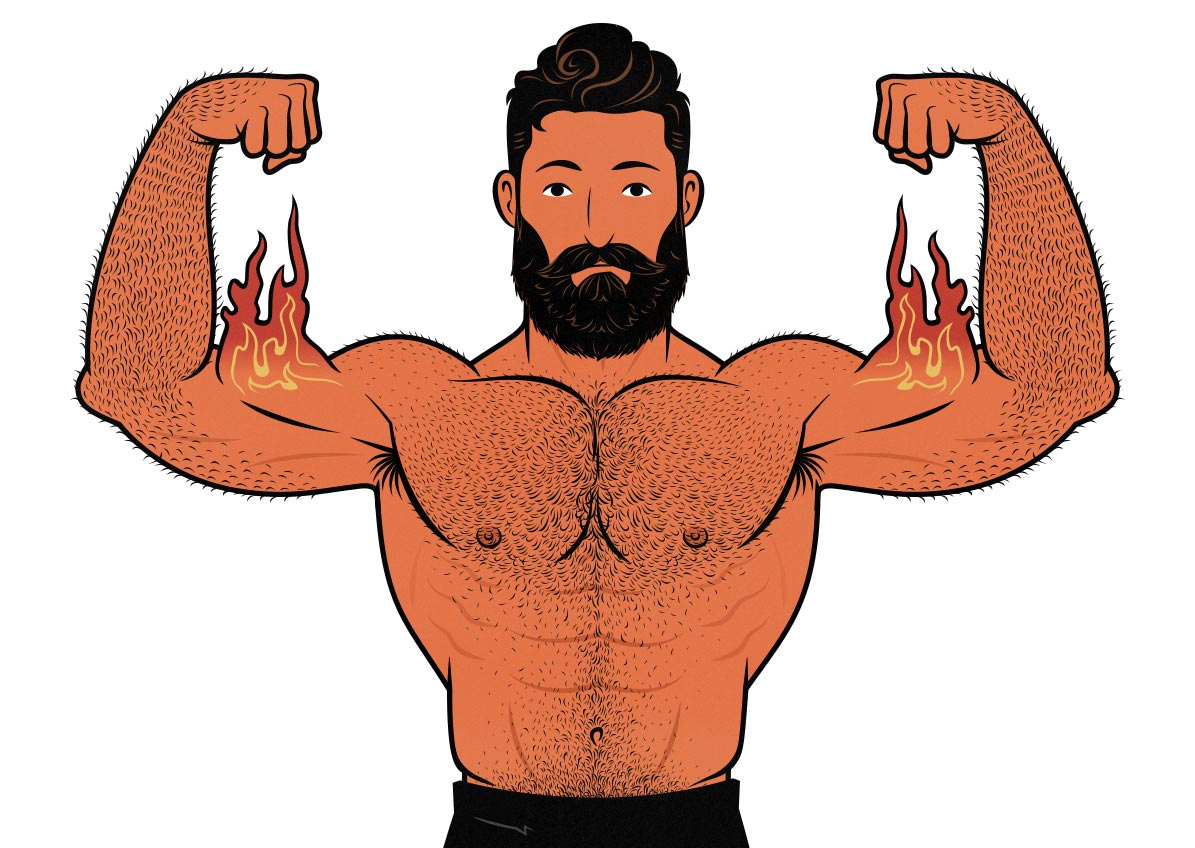
Combining Long & Short Rest Times
Long rest periods are better for gaining maximal strength. Short rest periods are better for improving work capacity and fitness. Both are good for gaining muscle size. So, if you’re training for muscle size, and you’re interested in collecting as many extra benefits as possible, you should use a mix of both shorter and longer rest periods.
You could use longer rest times when doing your big compound exercises. That will be great for gaining strength. Then you could use shorter rest times for your isolation lifts, making your workouts more efficient and giving you some extra fitness benefits.
You could also train with shorter rest periods for a few weeks, build some muscle, and then switch over to longer rest periods, building even more muscle.
Here’s how to do it:
- Big compound lifts: best to use longer rest times so that we can lift heavy and gain strength. However, using short rest times can be a great way to improve our fitness, so they have a role as well.
- Smaller isolation lifts: shorter rest times can work very well, allowing us to sneak in a ton of extra volume in a short amount of time, build up a fearsome pump, and improve nutrient delivery to those muscles.
- Strength phases: to build muscle and gain strength, it can help to use longer rest times.
- Fitness phases: if we’re trying to improve our cardiovascular fitness, lifting fitness, or general health, it can help to use shorter rest times.
- Longer workouts: if we have the time for longer workouts, then feel free to take some extra rest time. We’ll be able to use higher training volumes and recover our strength between sets.
- Shorter workouts: if we don’t have much time to work out, it’s probably best to cram as much volume as we can into our workouts, so short, strict rest times are best. And if we don’t have enough time to do dedicated cardiovascular training, at least we’ll be getting better cardio adaptations from our lifting.
Supersets & Giant Sets
Another way to combine shorter and longer rest times is to use supersets and giant sets. Here’s how to do that:
- Antagonist supersets: an antagonist superset is when we pair two lifts together that work opposing muscles. For example, we could pair chin-ups (biceps and back) with overhead presses (shoulders and triceps). We might still have rest periods between each lift, but we might rest one minute between sets instead of three, allowing us to essentially sneak our overhead pressing into the rest periods of our chin-ups, getting twice as much done in the same amount of time. Other examples of antagonist supersets are bench presses with barbell rows, biceps curls with triceps extensions, neck curls with neck extensions, and wrist curls with wrist extensions.
- Giant sets: a giant set is when a few different exercises are strung together into a circuit. For example, we could do a set of biceps curls, a set of lateral raises, and then a set of hanging leg raises. As with supersets, we can rest between sets, but the idea is to rest only long enough to ensure our cardiovascular systems aren’t the limiting factor. If these exercises aren’t overly tiring, we can get a lot of work done in a short amount of time while still giving our muscles enough time to recover between sets.
How Long Should You Rest Between Sets?
Long rest periods are better for strength training, and they stimulate more muscle growth per set. Short rest periods are better for improving work capacity, and they help you build more muscle in less time.
To get the advantages of longer rest times, let your breathing almost return to normal between sets. That usually takes 1.5–5 minutes, depending on how strong and fit you are and how big the exercise is.
To get the advantages of shorter rest times, use strict rest times between sets. Usually, that’s 1–2 minutes of rest for compound lifts and 30–60 seconds for smaller isolation lifts. You could also use drop sets, supersets, and giant sets.
If you’re trying to build muscle, gain strength, and improve your health, it’s probably best to use both long and short rest times in your hypertrophy training programs. You could use longer rest times on compound lifts and shorter rest times on isolation lifts. You could also use different styles of training in different training phases.

Alright, that’s it for now. If you want more muscle-building information, we have a free muscle-building newsletter. If you want a full exercise, diet, and lifestyle program to help you build muscle and improve your health, check out our Bony to Beastly Program (for guys) or Bony to Bombshell Program (for women). Or, if you’re already an intermediate lifter, check out our Outlift Hypertrophy Program.





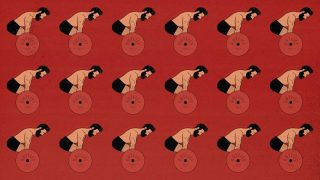
Is it more effective if I do a compound workout and rest longer than 2 minutes?
Hey Kirubel, are you talking about doing a workout make up of compound exercises? You can rest longer than 2 minutes between exercises. That’s no problem. And compound lifts are often the ones that are more tiring, where longer rest times can help you regain your strength between sets 🙂
The breathing rule is a good one, and heart rate works pretty good too. (And these days, with smart watches that show the heart rate at a glance, it doesn’t have to be so subjective.) Once breathing and heart rate are back down to where they were before the last set, it’s time for the next one.
Totally 🙂
This has been something I’ve been teaching and preaching for years. Some of my workouts are lower volume and heavier weights and take 2 hours. Other workouts are higher volume and lighter weights and take an hour. The key is intensity and how you get there through volume, load, rest and shock. Shock is accomplished by switching routines, changing exercises, drop sets, power sets, push/pulls, negatives, holds, etc. Great article.
Thank you, Ryan. I totally agree. Cool how you call it “shock.” That’s a good way of putting it.
How long should a person rest between workouts?
We’ve got a full article about how often you should work out. To sum it up quickly, though, our muscles grow best when we train them at least twice per week.
That means that a lot of different workout splits can be ideal. 3 full-body workouts per week, 4 push/pull workouts per week, 6 push/pull/legs workouts per week, and so on 🙂
For those of us working from home (and working out at home), I’m curious if you guys see any disadvantage to spacing sets throughout the day. That way computer time gets broken up, and it seems from this article that the more time between sets the better. Even if they’re 30 minutes or hours apart?
Great article as usual guys.
Hey More, that’s a great question!
I was curious about that, too. I asked three hypertrophy exerts/researchers: James Krieger, MS, Menno Henselmans, MS, and Mike Israetel, PhD. They all more or less agreed that spreading sets out over the day shouldn’t have a big impact on results. It’s also unclear whether it would have a slightly positive or negative effect.
I also spent a few months testing it out with my weighted chin-ups. I’d leave 60 pounds attached my weight belt, and I’d spread out 3–5 sets over the course of the day. At other times, I’ve used that same approach with push-ups. And I like it. I made good progress on the lifts, which is a pretty good indicator of muscle growth over time.
As for advantages, like you’ve said, it’s a great way to add some activity into your day. It’s also a good way to fully recover between sets, allowing you to perform great on each set.
For disadvantages, it isn’t always practical. Let’s say that you’re doing a heavy lift that requires warming up. It might take you 10 minutes of warming up before getting to a working set, meaning that if you’re spreading out four sets over the day, you’ve just spent 30 extra minutes warming up.
So if we’re talking about push-ups or chin-ups, which most people can just do on the fly, no warm-ups required, then there’s no known disadvantage. I’d go for it. If you’re talking about 12-rep sets of biceps curls, again, probably fine. But if you’re doing 4-rep sets of heavy squats or deadlifts with serious weight on the bar, might be better to do all your sets at once so you aren’t spending your entire day warming up and moving plates around.
Very interesting to read this comment as I too work from home and spread out my workout throughout the day. I used to do supersets to speed things up but have recently switched to just doing straight sets. I spread out the exercise rather than the actual sets of that exercise as it then just means the one warm up for that exercise. It also means I am fully recovered between each exercise.
That sounds like a pretty solid way of doing it 🙂
I squeeze my workout during lunch break which gives me about 50 minutes net to train.
For me the opposing muscles superset works very well. I just focus on big compound moves such as deadlift, squats , benchpress, weighted pull ups or chinups ,rep range is between 3 to 8 and get about 3 minutes rest between supersets.
BTW , I read the your article about supersets as well and very informative.
glad I found this website.
Thank you so much, Shay!
Your approach sounds awesome 🙂
I usually rest 5min between sets. It allows you to perform the exercise nicely til the end, with form, and you can even squeeze in some extra reps.